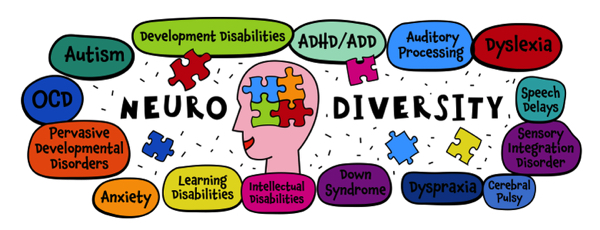Autism and ADHD: A study of two journeys in the brain's attention highway
By oliviacook // 2025-04-26
Tweet
Share
Copy

- ADHD is a neurological difference centered on attention regulation, often involving a need for stimulation, distraction and impulsivity.
- Autism involves a suite of neurological differences – including emotional, sensory and social processing – and may include attention differences (both over- or under-regulated).
- Both conditions can involve difficulty regulating attention, but with different underlying causes and patterns.
- Uneven abilities (e.g., excelling in some areas while struggling in others) are a hallmark of autism but not necessarily of ADHD.
- Diagnosis is complex – overlapping traits can mask or mimic each other and context matters.
- ADHD = a single color; autism = the full rainbow – the neurodiversity metaphor helps illustrate the complexity and richness of each condition.
Same behavior, different brain
At a glance, kids (and adults) with ADHD or autism can seem very similar. Both might struggle with focus, have difficulty in social situations or show intense interest in certain activities. But what's going on under the surface isn't always the same. Imagine two people, both standing still in the middle of a rainy street. On the surface, their behavior looks the same, but their reasons for standing there might be completely different. One may be stuck because they're "under-regulated" – distracted, overwhelmed and unable to figure out what to do next. The other might be "over-regulated" – hyper-focused on finishing a specific mental checklist before moving. Same behavior but different brain patterns – and different kinds of support would help each person. ADHD is primarily about under-regulation of attention: trouble focusing, sitting still or waiting your turn. It is powered by emotion and stimulation – when something is exciting, the brain kicks into overdrive. When it's not, starting can feel impossible. Autism, on the other hand, can involve over-regulation – difficulty switching gears, letting go or adapting to change. Autistic people may focus so intensely that they lose track of time or struggle to transition between tasks, even when they want to. But autism also includes a much wider range of neurological differences beyond attention, from sensory sensitivities to emotional processing and social perception.Attention: Too little, too much or just different?
Attention is not one-size-fits-all. Some people have trouble starting a task, others can't stop. Some bounce between ideas, others get stuck in a loop. Here's how these differences play out:- ADHD often looks like inattention and impulsivity – losing focus, forgetting instructions or acting without thinking.
- Autism can look like hyperfocus, obsession or rigidity – staying locked onto a single activity, idea or thought, sometimes to the exclusion of everything else.
- Both conditions can struggle with regulation – it's just that the "traffic jam" in the brain happens for different reasons.
Diagnosing by differences – not just deficits
Because ADHD and autism share traits – and because those traits can show up in wildly different ways – diagnosis can be tricky. One person may seem distracted, another inflexible. One may avoid eye contact, and another may speak nonstop. But beneath these behaviors are brains wired to see and respond to the world differently. It is not just about what's "wrong" – it is about how someone's brain works. That is why it is so important to look at the pattern of strengths and challenges. Not just "Can they pay attention?" but "What do they pay attention to – and how. What helps or hurts their focus? Do they hyperfocus or zone out? Can they switch tasks? How do emotions or sensory input affect them?"Different paths, shared needs
At the end of the day, whether someone has ADHD, autism, both or something else entirely, what matters most is understanding the individual. Not every kid who blurts out answers has ADHD. Not every quiet child has autism. And, not everyone with one diagnosis fits the mold. Science is still catching up to the lived experiences of neurodivergent people. But people are learning that these are "conditions," not "disorders" to be fixed – they are variations in how the brain engages with the world. Some people need support with focus. Others with transitions. Some need support with communication, others with sensory overwhelm. And some need all of the above – just in different ways. Neurodiversity is complex. It is messy and it is human, so keep learning – and make space for every kind of brain. Watch this video about how a woman's ADHD hides her autism. This video is from the Daily Videos channel on Brighteon.com.More related stories:
AUTISM or something else? The MISDIAGNOSIS problem and how to get the right diagnosis. ADHD: Misdiagnosed and overmedicated. How the 'rampantly overused' ADHD label overlooks other REAL diseases. Sources include: PMC.NCBI.NLM.NIH.gov AspergersFromTheInside.com Brighteon.comTweet
Share
Copy
Tagged Under:
brain function autism adhd mental brain ASD Autism spectrum disorder mind brain science neurodevelopment disorders neurodiversity autism acceptance ADHD awareness invisible disabilities attention regulation
You Might Also Like
Rethinking the nexus of science, technology and governance: Murray Rothbard’s radical vision
By Belle Carter // Share
“Vaccine Epidemic” sparks debate on human rights, health and corporate influence
By Belle Carter // Share
Recent News
HARVARD POLL: Congressional Democrats' approval among young voters plummets, GOP gains ground
By lauraharris // Share
Trump retreats on auto tariffs, plans to exempt CAR PARTS from duties
By ramontomeydw // Share
HHS Secretary Kennedy considers removing COVID-19 vaccine from childhood immunization schedule
By bellecarter // Share
Department of Education resumes collections on defaulted student loans
By lauraharris // Share











